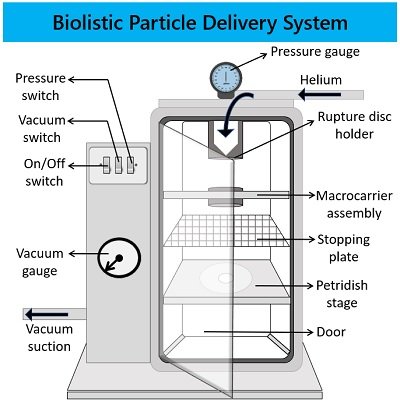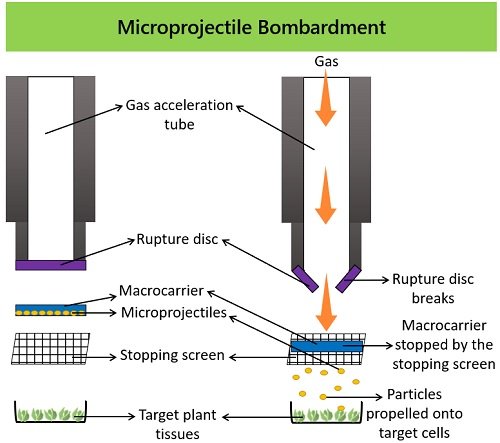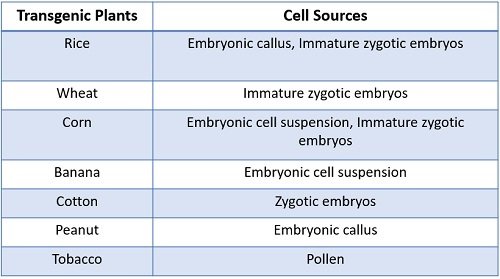Microprojectile bombardment is also called particle acceleration or gene gun delivery. It is one of the efficient physical methods of gene transfer in plants. Besides plants, it can also transfer genes to mammalian cells and microorganisms.
It is a direct method of transferring the gene of interest to target cells. By employing this method, we can produce transgenic or genetically modified plants. Sanford named the microprojectile bombardment method as biolistics.
Biolistic is a method delivering genes to different plants, animals and microbial cells. It employs high-speed particle bombardment for gene transfer.
PDS-1000/HC apparatus or gene gun device can be used in the biolistic system. These instruments ease the bombardment of the gene-coated particles. Thus, by employing either of the two devices, we could transfect target cells or tissues.
This post discusses the meaning, requirements, procedure and factors affecting the microprojectile bombardment. Also, you will get to know the advantages and disadvantages.
Content: Microprojectile Bombardment
Meaning of Microprojectile Bombardment
Microprojectile Bombardment of plant tissues is a method of producing chimeric plants by shooting the coated gene into plant tissues or seedlings. It was pioneered by Sanford in 1988.
The method uses microscopic gold or tungsten particles to coat the macromolecules. Exogenous DNA, RNA or proteins are the common macromolecules transferred into plant tissues.
Gene gun or Biolistic transformation is the alternative term. As the term “Gene gun” implies, the method works by bombarding genes into the plant cells.
The Success of Bombardment
The particle bombardment technique has achieved huge success in producing transgenic plants. Maize was the first transgenic crop developed through this method. And, Bt-toxin genes were incorporated into the maize tissues. Let us look into the list of transgenic plants along with the cell sources.
Points to Remember
Before proceeding to the whole concept of the gene gun method in plants, have a look into the following:
- Plant Genetic Transformation is a genetic engineering technology. It involves the transfer of desired genes into the target host cell. The gene transfer may occur among different plants. Or, it may also transfer the foreign genes into the host genome.
- Transgene represents the transferred gene.
- Plant transgenesis refers to the genetic transformation method in plants.
- Transgenic plants are genetically transformed new plants.
Components of Biolistic Particle Delivery System
We can use handheld instruments like gene guns or PDS-1000/HC for gene transfer. Here, we will discuss the basic components of the PDS-1000/HC system:

1. Gas acceleration tube
The interior of the bombardment chamber contains a gas acceleration tube at the top. For the bombardment, it uses compressed helium as the propellant. The gas pressure builds within this tube.
2. Rupture disc
Rupture disc retaining cap seals the rupture disc. And, the disc is placed against the end of the gas acceleration tube. It is a one-time-use circular membrane.
Rupture discs respond to any changes in the system pressure. In PDS-1000/HC system, it responds to the gas pressure.
High gas pressure results in breakage of the rupture disc. Metal, plastic or graphite can be used to construct a rupture disc.
3. Macrocarrier assembly
The macrocarrier sheet provides a support matrix for the loading of microprojectile. Macrocarrier is in close vicinity towards the rupture disc.
The Microprojectile bombardment method uses microcarriers of heavy metal microparticles. Gold, tungsten, platinum, and iridium are the common metal particles. Microprojectiles are DNA-coated microcarriers.
4. Stopping plate
It is present between the macrocarrier assembly and target plant cells. But, microparticles pass through the screen into the bombardment chamber. At last, the microprojectiles penetrate the target cells.
5. Target shelf
Here, we need to keep the Petri dish containing plant cells. Noting that, the plate should be in the path of macrocarrier assembly. The gene gun method uses two types of plant tissues.
- Primary explants are the part of a plant that owns the regeneration potential. These are capable of producing the whole new plant.
- Proliferating embryonic tissues of plants can be also used.
6. Bombardment Chamber Door
It controls the supply of electrical power into the chamber.
7. Connective tubings
These provide attachment of vacuum, pressure, gas and other sources to the main unit.
Biolistic Particle Bombardment Procedure
The procedure of gene transfer through a biolistic delivery system involves the following stages:
Stage1. Surface Sterilization
- Surface sterilize the workstation of the laminar airflow. Also, sterilize the interior and exterior surfaces of the biolistic system. For the surface sterilization, we can use 70% EtOH.
- Then, autoclave the following parts:
- Removable metal gun parts
- Stopping screens
- Macrocarrier holders
- Forceps.
- Sterilize macrocarriers or flyers in 70% EtOH for 1 hour.
- After that, move the flyers to a sterile petri dish. Then, keep the Petri plate near the blower to dry.
Note: Allow to dry the flyers for at least 20-30 minutes. Also, make sure that all gun parts are completely dry.

Stage2. Transgene Integration in Bombardment
Gene transfer in microprojectile bombardment includes two phases:
1. Preintegration Phase
Here, we need to first splice up the vector DNA. By doing this, we get DNA fragments carrying multiple gene copies. Later, we have to precipitate the genes onto the microparticles. The biolistic system employs tungsten or gold microparticles for gene delivery in plants.
Note:
- The average size of microparticles must be 1.0 µm.
- The use of tungsten nanoparticles is common. But, the use of tungsten proves to be toxic for certain plant species.
- Gold microparticles are costly. But, they are bioinert materials and show positive ionization.
- Nowadays, the use of silica is also common.
The steps of the preintegration phase are explained hereunder:
- We can use the DNA coated with gold particles. Then, using sterile forceps to load the coated microparticles onto a macrocarrier membrane. Macrocarrier assembly is adjustable.
- Move the macrocarrier upside down and keep it below the assembly of the rupture disc. Then, place the stopping screen below the macrocarrier.
- Keep the plant material over the sample holder.
- Biolistic system uses a compressed inert gas like helium for the gene delivery. Helium gas travels down the gas acceleration tube at a pressure on the order of 200-300 psi.
- The pressure continues to build until the rupture disc breaks. This allows the movement of the macrocarrier towards the stopping screen.
- The stopping screen retains the macrocarrier.
- A force of momentum generates when the macrocarrier strikes the stopping screen. As a result, the DNA-coated microparticles dislodge from the stopping plate.
2. Integrative Phase
Here, the desired gene copies integrate within the host plant genome.
- The microparticles travel down to the bombardment chamber. And, there these microparticles interact with the plant’s tissue.
- Some particles will penetrate the plant’s cell wall. As they pass through, some of the DNA may stripe off from the gold by simple shear forces. As a result, the DNA will integrate within the chromatin material of the nucleus. Whereas, some particles may present in the cell cytosol.
Factors Affecting Bombardment
For the efficient working of the particle bombarding system, the optimization of the following factors is necessary.
1. Nature of Microparticles:
The system uses inert metals (tungsten, gold, platinum) as microparticles. These metals have a high density and carry hundreds of DNA fragments. Due to high density, the particles move faster and penetrate tissues.
2. Nature of Tissues:
Particle bombardment method uses plant’s tissues that are capable of undergoing transformation.
3. Amount of DNA:
A low DNA concentration results in least transformation. Even so, high DNA concentration may cause the reorganization of transgenes. Thus, we must use a balanced quantity of DNA.
4. Environmental Factors:
Temperature, humidity, photoperiod etc. influence the physiology of the plant material. Plant tissues after bombardment need optimum light, temperature and humidity to grow.
Advantages
- Gene transfer is successful in transferring genes to intact plant tissues.
- The gene gun method uses different plant species to produce chimeric plants.
Limitations
- Microprojectile bombardment results in instability of transgene expression due to gene silencing.
- The target plant tissues may get damaged due to uncontrolled bombardment velocity.
- Sometimes, the gene gun method causes the regeneration of undesirable transgenic plants.
Conclusion
Thus, the particle bombardment method is a part of the gene delivery system. The method involves the acceleration of the DNA-coated nanoparticles. The ballistic system uses either of the approaches for particle acceleration:
- Pressurized helium gas
- Electrostatic energy from the water droplet
- Energy through the modified blank cartridge
Gene gun is extensively used device for the gene transfer. But, these days PDS-1000/HC apparatus is widely used to perform microprojectile bombardment.

The biology reader page is helping me a lot in studying and making notes easily. Thank you so much, I am stydying M.sc. Microbiology so , if possible, update topics related to microbiology more..
THANK You